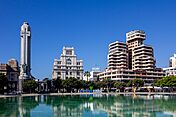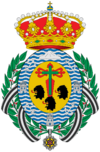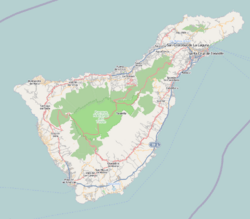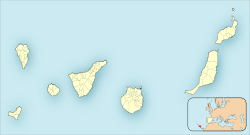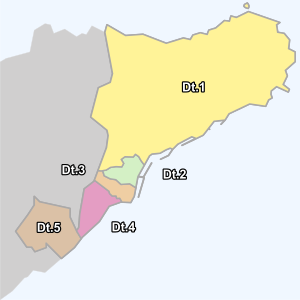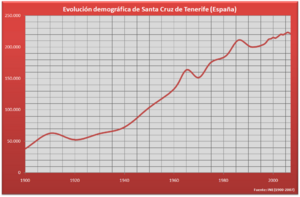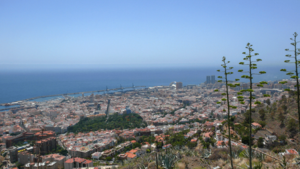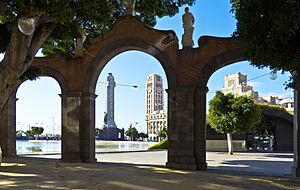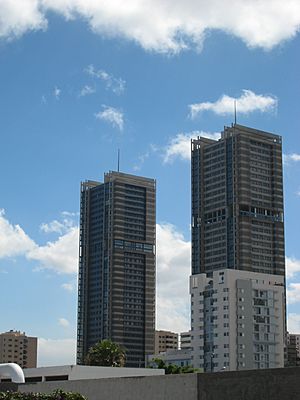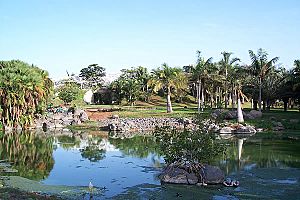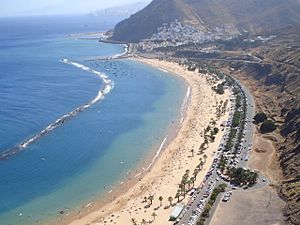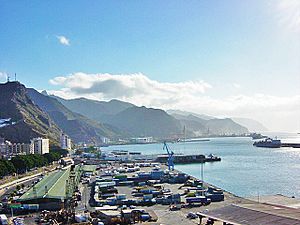Santa Cruz de Tenerife facts for kids
Quick facts for kids
Santa Cruz de Tenerife
|
|||
|---|---|---|---|
|
|
|||
|
|||
| Nickname(s):
"La Capital Chicharrera", "La Capital Tinerfeña", "La Capital Santacrucera", "The Sydney of the Atlantic".
|
|||
| Country | Spain | ||
| Autonomous community | Canary Islands | ||
| Province | Santa Cruz de Tenerife | ||
| Island | Tenerife | ||
| Founded | 3 May 1494, founded as "Real de la Santa Cruz" | ||
| Area | |||
| • Municipality | 150.56 km2 (58.13 sq mi) | ||
| Elevation | 4 m (13 ft) | ||
| Population
(2018)
|
|||
| • Municipality | 204,856 | ||
| • Density | 1,360.63/km2 (3,524.01/sq mi) | ||
| • Urban | 538,000 | ||
| Demonym(s) | Santacrucero, ra Chicharrero, ra | ||
| GDP | |||
| • Metro | €17.138 billion (2020) | ||
| Time zone | WET | ||
| • Summer (DST) | WEST | ||
| Postal code |
38001-38010, 38107, 38108, 38110, 38160, 38320
|
||
| Dialing code | +34 922, +34 822 | ||
| Language | Spanish | ||
Santa Cruz de Tenerife (pronounced SAN-tah Krooth deh teh-neh-REE-feh), often called Santa Cruz, is a big city in Spain. It is the capital of the island of Tenerife and one of the two capitals of the Canary Islands. The other capital is Las Palmas. Santa Cruz has over 200,000 people living in it, and if you include the areas around it, the population is much larger. It is the second-biggest city in the Canary Islands.
Santa Cruz is on the northeast side of Tenerife. It is about 210 kilometers (130 miles) from the coast of Africa in the Atlantic Ocean. The closest part of mainland Spain is about 1,300 kilometers (800 miles) away. For a long time, Santa Cruz de Tenerife was the only capital of the Canary Islands. But in 1927, the islands were split into two provinces, and Las Palmas became a co-capital.
The city's port is very important. It connects Europe, Africa, and the Americas, with many cruise ships visiting. Santa Cruz is also a main hub for travel between the different Canary Islands.
Many important government buildings are in Santa Cruz. These include the Parliament of the Canary Islands and some government ministries. The city also has parts of La Laguna University, like the Fine Arts School. Santa Cruz is famous for its huge Carnival, which is one of the biggest in the world!
The buildings in Santa Cruz are very interesting. The Auditorio de Tenerife (Tenerife Auditorium) is a modern building that looks like a giant wave. The Torres de Santa Cruz (Santa Cruz Towers) are the tallest twin towers in Spain, standing 120 meters (394 feet) high. Other famous places include the Plaza de España (Spain Square), which is the main square, and the Parque García Sanabria (García Sanabria Park), a large park in the city center. Outside the city, you can find Playa de Las Teresitas (Las Teresitas Beach) and a big part of the Macizo de Anaga (Anaga Massif), which is a special natural area protected by UNESCO.
In 2012, a British newspaper called The Guardian said Santa Cruz de Tenerife was one of the five best places in the world to live! A large part of Santa Cruz's land is natural area, especially the Anaga Rural Park. This makes Santa Cruz one of the Spanish cities with the most natural land.
Contents
- What's in a Name? The Story of Santa Cruz
- A Look Back: Santa Cruz's History
- How Santa Cruz is Organized
- People of Santa Cruz
- Getting Around Santa Cruz
- What Santa Cruz is Known For: Economy and Culture
- Places to See in Santa Cruz
- Shopping in Santa Cruz
- Sports in Santa Cruz
- Learning in Santa Cruz: Education
- City Celebrations
- Santa Cruz's Port
- Climate in Santa Cruz
- International Connections
- Famous People from Santa Cruz
- See also
What's in a Name? The Story of Santa Cruz
The area where Santa Cruz is today was once called Añazo or Añaza by the Guanches. The Guanches were the first people who lived on the island. Over time, the city had a few different names. Its current name, Santa Cruz de Tenerife, means "holy cross of Tenerife." This name remembers the day the city was founded, when a Christian cross was placed in the center of town.
A Look Back: Santa Cruz's History
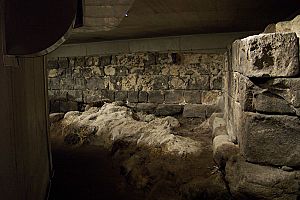

Early Days: Guanches and Conquerors
People have lived in the Santa Cruz area for about 2,000 years. This is known from old tools and sites found from the Guanches. The Guanches were the first people to live on Tenerife. This area was part of the Menceyato de Anaga, one of the nine kingdoms on the island. The famous Mummy of San Andrés is an important discovery from this time.
On May 3, 1494, Spanish soldiers led by Alonso Fernández de Lugo landed on the beaches where the city now stands. They set up a military camp, which grew into the city. This was the start of the Spanish conquest of Tenerife. To mark the founding, Alonso Fernández de Lugo placed a large wooden cross. This was done on the day of a Catholic holiday called the Invention of the Cross. After the conquest, the island's first capital was set up in San Cristóbal de La Laguna in 1496.
Growing into a Port City
Santa Cruz later became one of the most important ports in the Atlantic Ocean. It still is today! This small fishing village grew a lot after a volcano destroyed the port of Garachico in the 1700s. Santa Cruz then became the main port on the island.
The city gained its independence from La Laguna. In the 1800s, King Ferdinand VII made it the capital of the Province of Canary Islands. From 1833 to 1927, Santa Cruz de Tenerife was the only capital of the Canary Islands. But in 1927, a royal order said that the capital status would be shared with Las Palmas in Gran Canaria. This is still how it works today.
In 1893, a serious illness spread through the city. It was brought by a ship from Brazil. Sadly, 382 people died.
During the Spanish Civil War (1936-1939), the Canary Islands were on General Francisco Franco's side. The mayor of Santa Cruz, José Carlos Schwartz Hernández, was arrested and killed in 1936. After the war, there were many years of economic hardship.
Since 1978, with Spain's new Constitution, Santa Cruz has had mayors chosen by the people. In the 1980s and 1990s, the city grew a lot. New areas like Cabo-Llanos were built, with tall buildings and streets that look like American cities. People called this "Manhattanization".
Santa Cruz in the 21st Century
The 2000s started with more growth and new buildings. Famous structures like the Auditorio de Tenerife, designed by Santiago Calatrava, and the redesigned Plaza de España were built.
On March 31, 2002, a very heavy rainstorm hit the city. It caused flooding, and sadly, 8 people died, 12 went missing, and many were injured.
Santa Cruz and its neighbor, San Cristóbal de La Laguna, have grown so much that their suburbs have merged. They now form a large metropolitan area with over 420,000 people. There were talks about joining the two cities politically, but this idea was put on hold.
The global financial crisis from 2007-2008 slowed down the city's development for over ten years. In 2018, it was announced that the Santa Cruz de Tenerife Refinery would be taken apart. This will allow the city to expand even more to the south.
How Santa Cruz is Organized
Santa Cruz is divided into five main areas called districts. These districts are then split into smaller areas.
| No | District | Population |
|---|---|---|
| 1 | Anaga | 14,135 |
| 2 | Centro-Ifara | 53,652 |
| 3 | La Salud-La Salle | 70,120 |
| 4 | Ofra-Costa Sur | 47,977 |
| 5 | Distrito Suroeste | 41,136 |
People of Santa Cruz
In 1990, Santa Cruz's population went above 200,000 people. Santa Cruz de Tenerife and San Cristóbal de La Laguna are so close that they form one big urban area with over 380,000 people.
Santa Cruz has a more modern feel compared to the nearby city of La Laguna. According to a study, Santa Cruz de Tenerife has the highest life expectancy among the Canary Islands' capitals, at 81 years.
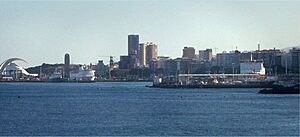
| Year | Population |
|---|---|
| 1991 | 200,172 |
| 1996 | 203,787 |
| 2001 | 188,477 |
| 2002 | 217,414 |
| 2003 | 220,022 |
| 2004 | 219,466 |
| 2006 | 221,956 |
| 2007 | 220,902 |
| 2008 | 226,232 |
| 2013 | 206,593 |
Many people from other countries live in Santa Cruz. In 2018, the largest groups were from:
| Venezuela | 9,608 |
| Cuba | 3,940 |
| Argentina | 1,659 |
| Bolivia | 1,569 |
| Colombia | 1,558 |
| Italy | 1,097 |
| Morocco | 702 |
| Ecuador | 655 |
| Uruguay | 627 |
| China | 558 |
Getting Around Santa Cruz
Santa Cruz is the main transport hub for Tenerife.
- The Autopista TF-1 motorway connects Santa Cruz with the south of the island, including popular tourist resorts.
- The Autopista TF-5 connects Santa Cruz with the north of the island, like Puerto de la Cruz.
The Santa Cruz harbour is one of the busiest in Spain. It handles ferries, cruise ships, and cargo ships.
Tenerife North Airport is close to the city. The larger Tenerife South Airport is about 75 kilometers (47 miles) south. There are plans to build a railway to connect this airport to the capital.
The Intercambiador is a big transport station. It's where all the city buses and the Tenerife Tram services meet.
What Santa Cruz is Known For: Economy and Culture
Santa Cruz de Tenerife has the most shops in the Canary Islands. The city's economy mainly relies on services like trade, tourism, and import-export. The port and the many important businesses and government offices also help the economy. Building new structures is also a big part of the economy.
Cultural Places to Visit

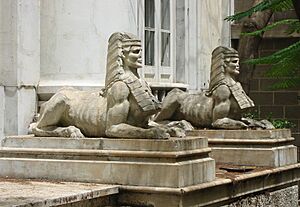
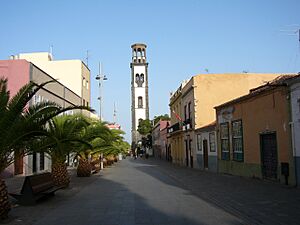
- Auditorio de Tenerife: This amazing building was designed by Santiago Calatrava. It looks like a giant wave or a ship's sail. It's a symbol of the city and hosts concerts, operas, and other events.
- Guimerá Theater: Opened in 1851, this is the oldest theater in the Canary Islands.
- Museum of Fine Arts: This museum has many important paintings, including some from the famous Prado Museum.
- Museum of Nature and Man: Here, you can learn about the history of the Guanches, the first people of the islands. It has real Guanche mummies and shows how the Canary Islands were formed.
- TEA – Tenerife Espacio de las Artes: This modern art space opened in 2008. It has a museum, a library, and a photography center.
Art in the City: Urban Sculptures
Santa Cruz has many sculptures around the city. You can find them along the Ramblas and in the Parque Garcia Sanabria. These include works by famous artists like Henry Moore and Joan Miró.
Fun Cultural Events
Santa Cruz hosts many exciting events throughout the year:
- Festival de Música Clásica de Canarias (Classical Music Festival)
- Festival de Ópera de Tenerife (Opera Festival)
- Tenerife International Film Music Festival
- Carnival of Santa Cruz de Tenerife: This is one of the biggest carnivals in the world! Thousands of people celebrate in the streets for over a week. It hopes to become a World Heritage Site.
- Día de la Cruz (Cross Day): Celebrates the city's founding.
- Recreation Gesta July 25: A historical reenactment of a famous battle.
Nightlife and Entertainment
While Santa Cruz used to be quieter at night, it now has many places to go out. The street called Antonio Dominguez Alfonso (also known as Calle La Noria) is popular for tapas, dinner, and drinks.
Places to See in Santa Cruz
- Auditorio de Tenerife (Auditorium of Tenerife): This iconic building is a must-see. It's shaped like a giant wave and is a symbol of the city.
- Torres de Santa Cruz (Towers of Santa Cruz): These twin towers are the tallest skyscrapers in the Canary Islands.
- Plaza de España (Spain Square): The largest square in the city, with a big artificial lake.
- Tenerife Espacio de las Artes (Tenerife Space of Arts – TEA): A modern building housing a museum, library, and photography center.
- Parque García Sanabria: A beautiful public park with fountains and sculptures. It's the largest urban park in the Canary Islands.
- Playa de Las Teresitas: A famous beach in the nearby village of San Andrés.
- Museo de la Naturaleza y el Hombre (Museum of Nature and Man): Known for its amazing collection of Guanche mummies.
- Masonic Temple of Santa Cruz de Tenerife: Considered a fine example of a Masonic Temple in Spain.
In the areas around the city, you can explore:
- Macizo de Anaga
- Igueste de San Andrés
- Taganana
- San Andrés
Tall Buildings (Skyscrapers)
- Torres de Santa Cruz
- Rascacielos de la avenida Tres de Mayo
- Edificio Olimpo
- Edificio Juan Amador
Parks and Squares
- Parque García Sanabria
- Parque de La Granja
- Plaza de 25 de julio (de los Patos)
- Plaza de España
- Plaza de la Candelaria
- Plaza del Príncipe
- Plaza de Weyler
- Plaza del Chicharro
Churches and Historical Sites
- Iglesia de La Concepción (church)
- Iglesia de San Francisco de Asís (church)
- Iglesia de Nuestra Señora del Pilar (church)
- Iglesia de San José (church)
- Cabildo Insular de Tenerife (island's governing body)
- Castle of St John the Baptist or Castillo Negro
- Castle of San Cristóbal
- Castle of San Andrés
- Parlamento de Canarias (Parliament of the Canary Islands)
- Masonic Temple of Santa Cruz de Tenerife
Shopping in Santa Cruz
Santa Cruz is a great place to shop! You'll find many stores in the city center, especially on pedestrian streets like Calle Castillo. There are also big shopping centers in Avenida de 3 Mayo and in the southern suburbs like Añaza. For fancy designer shops, head to Calle del Pilar.
One great thing about shopping in Santa Cruz is the lower prices. Things like tobacco, alcohol, electronics, and even coffee are often cheaper than in other parts of Western Europe. This is because the Canary Islands have special, lower taxes on goods.
Sports in Santa Cruz
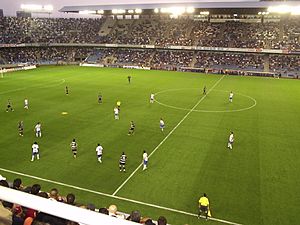
- CD Tenerife: This football (soccer) team was founded in 1912. They play their home matches at the Estadio Heliodoro Rodríguez López. The team has played in Spain's top league, La Liga, and even in a European competition once!
- CV Tenerife: Volleyball is also popular, especially women's volleyball. CV Tenerife was once a European champion.
- Lenovo Tenerife: This is a professional basketball team that plays in the top Spanish league.
Learning in Santa Cruz: Education
Santa Cruz has several international schools:
- Lycée Français de Tenerife "Jules Verne" (French school)
- Deutsche Schule Santa Cruz de Tenerife (German school) in nearby El Rosario
- Svenska Skolan Teneriffa (Swedish school) in nearby Arona
- British School of Tenerife with campuses in La Orotava, Los Realejos, and Puerto de la Cruz
- Wingate School (British school) in Arona
City Celebrations
- January 27: Celebrates the day Santa Cruz de Tenerife became the capital of the Canary Islands.
- February: The famous Carnival of Santa Cruz de Tenerife takes place. It's a huge party!
- May 3: May festivities, including Día de la Cruz (Day of the City of Santa Cruz de Tenerife).
- July 25: This day celebrates Saint James the Great (the patron saint of Santa Cruz) and remembers the defeat of Admiral Nelson in a battle. This is part of the Recreation Gesta July 25 events.
Santa Cruz's Port
The Port of Santa Cruz de Tenerife is a busy port for fishing, trade, passengers, and sports boats. It's the top fishing port in the Canary Islands and handles a huge number of passengers.
Climate in Santa Cruz
Santa Cruz has a warm climate, with sunny days and mild nights. The average temperature during the day is about 25°C (77°F) and at night it's about 18°C (64°F). Even in the coolest month, January, daytime temperatures are usually between 19-23°C (66-73°F). In the warmest month, August, it's usually between 26-32°C (79-90°F).
The city gets a lot of sunshine, about 2,887 hours per year. Most of the rain falls between November and March, and the summer months are usually very dry.
| Climate data for Santa Cruz de Tenerife (1991-2020) (Provisional Normals) | |||||||||||||
|---|---|---|---|---|---|---|---|---|---|---|---|---|---|
| Month | Jan | Feb | Mar | Apr | May | Jun | Jul | Aug | Sep | Oct | Nov | Dec | Year |
| Mean daily maximum °C (°F) | 21.1 (70.0) |
21.3 (70.3) |
22.1 (71.8) |
23.0 (73.4) |
24.5 (76.1) |
26.6 (79.9) |
28.8 (83.8) |
29.3 (84.7) |
28.2 (82.8) |
26.6 (79.9) |
24.2 (75.6) |
22.2 (72.0) |
24.8 (76.7) |
| Daily mean °C (°F) | 18.3 (64.9) |
18.4 (65.1) |
19.0 (66.2) |
19.9 (67.8) |
21.3 (70.3) |
23.2 (73.8) |
25.2 (77.4) |
25.8 (78.4) |
25.1 (77.2) |
23.6 (74.5) |
21.4 (70.5) |
19.5 (67.1) |
21.7 (71.1) |
| Mean daily minimum °C (°F) | 15.5 (59.9) |
15.4 (59.7) |
15.9 (60.6) |
16.8 (62.2) |
18.1 (64.6) |
19.9 (67.8) |
21.5 (70.7) |
22.3 (72.1) |
21.9 (71.4) |
20.6 (69.1) |
18.5 (65.3) |
16.8 (62.2) |
18.6 (65.5) |
| Average precipitation mm (inches) | 28.8 (1.13) |
33.7 (1.33) |
37.8 (1.49) |
10.3 (0.41) |
3.5 (0.14) |
0.6 (0.02) |
0.1 (0.00) |
3.5 (0.14) |
4.5 (0.18) |
24.4 (0.96) |
35.8 (1.41) |
36.8 (1.45) |
219.8 (8.66) |
| Average precipitation days (≥ 1 mm) | 4.0 | 3.5 | 3.6 | 2.2 | 0.8 | 0.1 | 0.0 | 0.4 | 0.8 | 3.2 | 5.0 | 4.9 | 28.5 |
| Average relative humidity (%) | 62.2 | 61.6 | 60.9 | 59.7 | 59.2 | 59.0 | 56.5 | 59.2 | 63.2 | 64.6 | 63.7 | 64.7 | 61.2 |
| Mean monthly sunshine hours | 187.8 | 191.5 | 235.1 | 253.3 | 289.2 | 312.0 | 346.3 | 329.9 | 267.8 | 227.9 | 179.9 | 177.8 | 2,998.5 |
| Source 1: Agencia Estatal de Meteorologia (AEMET OpenData) for temperatures and precipitation | |||||||||||||
| Source 2: NOAA for precipitation days, humidity and sunshine | |||||||||||||
| Climate data for Santa Cruz (1981–2010), Extremes (1920–2016) | |||||||||||||
|---|---|---|---|---|---|---|---|---|---|---|---|---|---|
| Month | Jan | Feb | Mar | Apr | May | Jun | Jul | Aug | Sep | Oct | Nov | Dec | Year |
| Record high °C (°F) | 28.4 (83.1) |
31.2 (88.2) |
35.4 (95.7) |
35.2 (95.4) |
36.4 (97.5) |
37.1 (98.8) |
42.6 (108.7) |
40.4 (104.7) |
39.3 (102.7) |
38.1 (100.6) |
34.0 (93.2) |
28.2 (82.8) |
42.6 (108.7) |
| Mean maximum °C (°F) | 22.6 (72.7) |
24.3 (75.7) |
24.9 (76.8) |
25.0 (77.0) |
26.3 (79.3) |
28.5 (83.3) |
31.1 (88.0) |
31.4 (88.5) |
29.7 (85.5) |
28.0 (82.4) |
26.0 (78.8) |
24.1 (75.4) |
31.4 (88.5) |
| Mean daily maximum °C (°F) | 21.0 (69.8) |
21.2 (70.2) |
22.1 (71.8) |
22.7 (72.9) |
24.1 (75.4) |
26.2 (79.2) |
28.7 (83.7) |
29.0 (84.2) |
28.1 (82.6) |
26.3 (79.3) |
24.1 (75.4) |
22.1 (71.8) |
24.6 (76.3) |
| Daily mean °C (°F) | 18.2 (64.8) |
18.3 (64.9) |
19.0 (66.2) |
19.7 (67.5) |
21.0 (69.8) |
22.9 (73.2) |
25.0 (77.0) |
25.5 (77.9) |
24.9 (76.8) |
23.4 (74.1) |
21.3 (70.3) |
19.4 (66.9) |
21.5 (70.7) |
| Mean daily minimum °C (°F) | 15.4 (59.7) |
15.3 (59.5) |
15.9 (60.6) |
16.5 (61.7) |
17.8 (64.0) |
19.5 (67.1) |
21.2 (70.2) |
21.9 (71.4) |
21.7 (71.1) |
20.3 (68.5) |
18.4 (65.1) |
16.6 (61.9) |
18.4 (65.1) |
| Mean minimum °C (°F) | 14.2 (57.6) |
14.0 (57.2) |
14.8 (58.6) |
15.2 (59.4) |
16.4 (61.5) |
18.2 (64.8) |
19.8 (67.6) |
20.6 (69.1) |
20.3 (68.5) |
18.9 (66.0) |
16.3 (61.3) |
15.3 (59.5) |
14.0 (57.2) |
| Record low °C (°F) | 9.4 (48.9) |
8.1 (46.6) |
9.5 (49.1) |
9.7 (49.5) |
12.0 (53.6) |
13.4 (56.1) |
16.5 (61.7) |
17.0 (62.6) |
16.8 (62.2) |
14.6 (58.3) |
10.1 (50.2) |
10.0 (50.0) |
8.1 (46.6) |
| Average rainfall mm (inches) | 31.5 (1.24) |
35.4 (1.39) |
37.8 (1.49) |
11.6 (0.46) |
3.6 (0.14) |
0.9 (0.04) |
0.1 (0.00) |
2.0 (0.08) |
6.8 (0.27) |
18.7 (0.74) |
34.1 (1.34) |
43.2 (1.70) |
225.7 (8.89) |
| Average rainy days (≥ 1.0 mm) | 4.2 | 3.8 | 3.8 | 2.4 | 0.9 | 0.2 | 0.0 | 0.3 | 0.9 | 3.1 | 4.7 | 5.4 | 29.7 |
| Average relative humidity (%) (daily average) | 64 | 63 | 62 | 61 | 61 | 61 | 58 | 61 | 65 | 65 | 64 | 67 | 63 |
| Mean monthly sunshine hours | 178 | 186 | 221 | 237 | 282 | 306 | 337 | 319 | 253 | 222 | 178 | 168 | 2,913 |
| Percent possible sunshine | 52 | 60 | 59 | 61 | 65 | 73 | 78 | 79 | 70 | 65 | 54 | 54 | 64 |
| Source 1: Agencia Estatal de Meteorología | |||||||||||||
| Source 2: Weatherbase, Weather Atlas (possible sunshine) | |||||||||||||
| Climate data for Santa Cruz de Tenerife | |||||||||||||
|---|---|---|---|---|---|---|---|---|---|---|---|---|---|
| Month | Jan | Feb | Mar | Apr | May | Jun | Jul | Aug | Sep | Oct | Nov | Dec | Year |
| Average sea temperature °C (°F) | 20.1 (68.3) |
19.4 (66.8) |
19.3 (66.7) |
19.5 (67.2) |
20.1 (68.3) |
21.1 (70.1) |
22.0 (71.5) |
22.8 (73.1) |
23.7 (74.6) |
23.6 (74.4) |
22.3 (72.1) |
20.8 (69.4) |
21.2 (70.2) |
| Mean daily daylight hours | 11.0 | 11.0 | 12.0 | 13.0 | 14.0 | 14.0 | 14.0 | 13.0 | 12.0 | 11.0 | 11.0 | 10.0 | 12.2 |
| Average Ultraviolet index | 4 | 6 | 8 | 9 | 10 | 11 | 11 | 11 | 9 | 7 | 5 | 4 | 7.9 |
| Source: seatemperature.org (sea temperature) | |||||||||||||
| Source: Weather Atlas | |||||||||||||
International Connections
Consulates
Many countries have consulates in Santa Cruz de Tenerife. A consulate is like a small embassy that helps citizens from that country who are traveling or living abroad.
- Austria
- Argentina
- Belgium
- Bolivia
- Brazil
- Chile
- Colombia
- Costa Rica
- Denmark
- Ecuador
- Finland
- France
- Germany
- Guatemala
- Honduras
- India
- Ireland
- Italy
- Liberia
- Mexico
- Monaco
- Netherlands
- Nicaragua
- Norway
- Peru
- Philippines
- Portugal
- Sri Lanka
- Sweden
- Turkey
- United Kingdom
- Uruguay
- Venezuela
Sister Cities
Santa Cruz de Tenerife has "sister city" relationships with other cities around the world. This means they share cultural ties and friendly connections.
|
|
Famous People from Santa Cruz
- Rafael Arozarena, (1923–2009), writer
- Fernando Fernández Martín (born 1943), politician
- Juan Carlos Fresnadillo (born 1967), film director
- Simón de Herrera (1754–1813), governor
- Julio Hormiga (born 1985), retired footballer
- Maria Rozman (1971–), news director
- Àngel Guimerà (1845–1924), writer
- Adán Martín Menis (1943–2010), politician
- Luis Molowny (1925–2010), football player
- Leopoldo O'Donnell (1809–1867), politician
- Alfonso de Orléans-Borbón, Duke of Galliera (born 1968), founder of Racing Engineering
- Ayoze Pérez (born 1993), football player
- Pedro, (born 1987), footballer
- Alberto Vázquez-Figueroa, (born 1936), writer
- Eduardo Westerdahl (1902–1983), art critic and author
- Andrew Wolfson (1890–1978), cricketer
|
See also
 In Spanish: Santa Cruz de Tenerife para niños
In Spanish: Santa Cruz de Tenerife para niños





